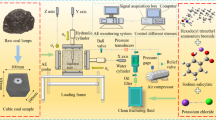Abstract
This study investigated the effects of high temperature and combustion conditions on the attrition of fluidized material in a fluidized bed. Silica sand was fluidized in air at an atmospheric pressure between 873 K and 1,073 K. The operating parameters evaluated in investigating the attrition rate of fluidized material included particle size, temperature and both combustion and non-combustion conditions. Experimental results indicated that the total weight of attrition increased with increasing temperature and decreased with increasing particle size. The attrition was higher during the initial fluidization period than the later period, due to the loss of sharp corners and edges of the attrition particles. The initial and final attrition rates during combustion were higher than those in the non-combustion condition, because the heat and thermal shock were produced to increase attrition rate during incineration. Comparing the experimental data with previous correlations, that reveals a significant level of error in the prediction results from existing correlations. This error may occur because the experimental equations neglected the operating temperature and particle size.
Similar content being viewed by others
References
Arena, V., D’Amore, M., Massimilla, L., “Carbon Attrition during the Fluidized Combustion of a Coal,”AIChE J.,29, 40 (1983).
Chirone, R., D’Amore, M., Massimilla, L. and Mazza, A., “Char Attrition during the Batch Fluidized Bed Combustion of Coal”AIChE J.,31, 812 (1985).
Choi, K. B., Park, S. I., Park, Y. S, Sung, S. W. and Lee, D. H., “Drying Characteristics of Millet in a Continuous Multistage Fluidized Bed,”Korean J. Chem. Eng.,19, 1106 (2002).
Chu, C. Y., Hsueh, K. W. and Hwang, S. J., “Sulfation and Attrition of Calcium Sorbent in a Bubbling Fluidized Bed,”J. of Hazardous Materials,B80, 119 (2000).
Cook, L. J., Khang, S. J., Lee, S. K. and Tim, C. K., “Attrition and Changes in Particles Distribution of Lime Sorbents in a Circulation Fluidized Bed Absorber,”Powder Technol,89, 1 (1996).
Geldart, D., “Types of Gas Fluidization,”Powder Technol,7, 285 (1973).
Gu, J. H, Yeo, W. H, Seo, Y C., Lee, S. H. and Lee, J. K., “The Characteristics of Co-incineration of Dewatered Sludge, Waste Oil and Waste Solvent in Commercial-scale Fluidized Bed Incineratof,”Korean J. Chem. Eng.,19, 324 (2002).
Gwyn, J. E., “On the Particle Distribution Function and the Attrition of Cracking Catalysts,”AIChE J.,15, 35 (1969).
Halder, P. K. and Basu, P., “Attrition of Spherical Electrode Carbon Particles during Combustion in a Turbulent Fluidized Bed,”Chem. Eng. Sci.,47, 527 (1992).
Han, K. H., Park, J., Ryu, J. I. and Jin, G. T, “Coal Combustion Characteristics in a Pressurized Fluidized Bed,”Korean J. Chem. Eng.,16, 804 (2001).
Jang, J. G., Kim, M. R., Lee, K. H. and Lee, J. K., “Enhancement of Combustion Efficiency with Mixing Ratio during Fluidized Bed Combustion of Anthracite and Bituminous Blended Coal”Korean J. Chem. Eng.,19, 1059 (2002).
Kage, H., Dohzaki, M., Ogura, H. and Matsuno, Y., “Powder Coating Efficiency of Small Particles and Their Agglomeration in Circulating Fluidized Bed,”Korean J. Chem. Eng.,16, 630 (1999).
Ko, M. K., Lee, W. Y., Kim, S. B., Lee, K. W. and Chun, H. S., “Gasification of Food Waste with Steam in Fluidized Bed,”Korean J. Chem. Eng.,18, 961 (2001).
Kono, H., “Attrition Rate of Relatively Coarse Solid Particles in Various Types of Fluidized Beds,”AIChE Symp. Ser.,77, 96 (1981).
Lee, S. K., Jiang, X., Keener, T. C. and Khang, S. J., “Attrition of Lime Sorbents during Fluidization in a Circulating Fluidized Bed Absorber,”Ind. Eng. Chem. Res.,32, 2758 (1993).
Lee, W I, Kim, S. D. and Song, B. H., “Steam Gasification of an Australian Bituminous Coal in a Fluidized Bed,”Korean J. Chem. Eng.,19,1091 (2002).
Lin, L., Sesrs, J. T. and Wen, C. Y., “Elutriation and Attrition of Char a Large Fluidized Bed,”Powder Technol.,27, 105 (1980).
Merrick, D. and Highley, I, “Particle Size Reduction and Elutriation in a Fluidized Bed Process,”AIChE Symp. Ser.,70, 366 (1974).
Park, Y S., Kim, H. S., Shun, D., Song, K. S. and Kang, S. K., “Attrition Characteristics of Alumina Catalyst for Fluidized Bed Incineratof,”Korean J. Chem. Eng.,17, 284 (2000).
Patel, K., Nienow, A. W. and Milne, L. P., “Attrition of Urea in a GasFluidized Bed,”Powder Technol.,47, 257 (1986).
Ray, Y. C. and Jiang, T. S., “Particle Attrition Phenomena in a Fluidized Bed,”Powder Technol.,49, 193 (1987).
Shamlou, P. A., Liu, Z. and Yates, J. G., “Hydrodynamic Influences on Particle Breakage in Fluidized Beds,”Chem. Eng. Sci.,45, 809 (1990).
Ulerich, N. H., Vaux, R. A., Newby, R. A. and Keairns, D. L., Experimental/Engineering Support for EPA’s PBC Program, Final Rep., EPA-600/7-80-015A, Westinghouse Research and Development Center, Pittsburgh, PA, USA, Jan. (1980).
Vaux, W. G. and Fellers, A. W., “Measurement of Attrition Tendency in Fluidization,”AIChE Symp. Ser,77, 107 (1981).
Vaux, W. G. and Kearins, D. L., in “Fluidization,” Grace, J. R. and Matsen, J. M., Eds., Plenum Press, New York, 437 (1980).
Vaux, W. G. and Schruben, J. S., “Kinetics of Attrition in the Bubbling Zone of Fluidized Beds,”AIChEJ.,79, 97 (1978).
Wey, M. Y. and Chang, C. L., “Kinetic Study of Polymer Incineration,”Polymer Degradation and Stability,48, 25 (1995).
Wu, S. Y. and Baeyens, I, “Effect of Operating Temperature on Minimum Fluidization Velocity,”Powder Technol.,67, 217 (1991).
Wu, S. Y. and Chu, C. Y., “Attrition in a Gas Fluidized Bed with Single High Velocities Vertical Nozzle,” World Congress on Particle Technology 3rd, Brighton, U.K., 152 (1998).
Wu, S. Y., Baeyens, J. and Chu, C. Y., “Effect of the Grid-Velocity on Attrition in Gas Fluidized Beds,”Can. J. of Chem. Eng.,77, 738 (1999).
Author information
Authors and Affiliations
Corresponding author
Rights and permissions
About this article
Cite this article
Lin, CL., Wey, MY. Effects of high temperature and combustion on fluidized material attrition in a fluidized bed. Korean J. Chem. Eng. 20, 1123–1130 (2003). https://doi.org/10.1007/BF02706947
Received:
Accepted:
Issue Date:
DOI: https://doi.org/10.1007/BF02706947




